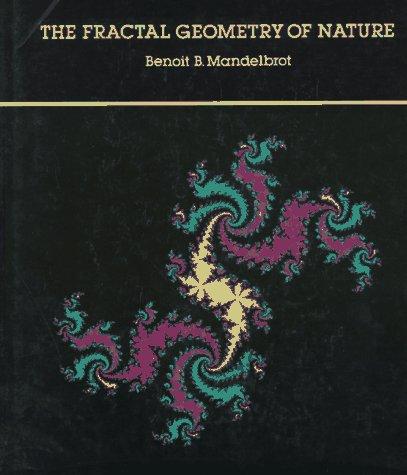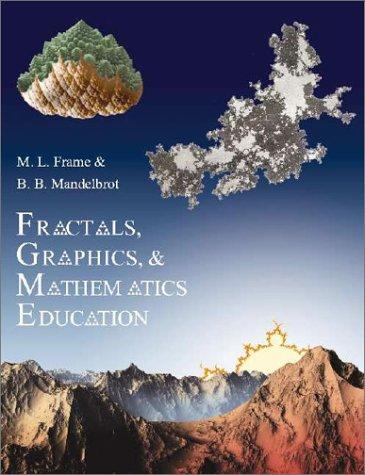Benoit Mandelbrot was a famous mathematician who changed the way people viewed and interacted with the shapes and geometry of the world. His life-long work developing and harnessing a field called fractal geometry saw wide-ranging influences across the physical and theoretical world.
Today we’re going to be looking at Benoit Mandelbrot: who he is, what his impact was, and what publications of his served to revolutionize the scientific community.
If you would like to learn about fractals generally, check out my post about the history of fractals.
Who Was Benoit Mandelbrot?
Table of Contents
- Fractals: Form, Chance, and Dimension
- The Fractal Geometry of Nature
- The Beauty of Fractals: Images of Complex Dynamical Systems
- The Science of Fractal Images
- An Eye for Fractals: A Graphic and Photographic Essay
- The (Mis)Behavior of Markets
- Fractals, Graphics, and Mathematics Education
- Fractals and Chaos: The Mandelbrot Set and Beyond
- Fractals and Scaling in Finance: Discontinuity, Concentration, Risk. Selecta Volume E
- References
Benoit Mandelbrot came from a Polish family who lived in France. Eventually, he emigrated to the United States and carried out an ambitious and influential career as a mathematician. He also had a wide variety of interests and studied the practical sciences. He created the field of fractal geometry and coined the term ‘fractal’ to describe the unique and visually appealing shapes. This came from what he called the “art of roughness” and “the uncontrolled element in life”. Mathematically, he linked the geometry of fractals to Chaos Theory.
To understand Mandelbrot is to understand the beauty and complexity of fractals. Found throughout nature, these self-same patterns have revolutionized the way people approach various industries including finance, art, technology, and more. Fractal geometry gives mathematicians the tools to better understand the world around us.
As the father of fractals, Mandelbrot contributed numerous works to publication over the years. Today we’re going to look at the list of books Mandelbrot published.
Book Cover images courtesy of the Internet Archive Open Library project.
Fractals: Form, Chance, and Dimension
1977 saw Benoit Mandelbrot publish Fractals: Form, chance, and dimension, the first of his published works on the subject of these never-ending, geometric-mathematical patterns that exist throughout nature.
Before Mandelbrot’s work on the subject, other mathematicians had examined different aspects of the problem. Mandelbrot saw these disconnected parts and united them into a coherent theory of study. In the 1960s and 70s, Mandelbrot developed the concept of fractal geometry – a theory that would go on to inform scientific theory in a wide range of industries.
Fractals: Form, chance, and dimension is a book that is expansive in its scope. It attempts to inform both technical audiences and general audiences alike.

It should be a book of interest to any person who is interested in the complex and captivatingly elegant patterns of fractals.
The book begins with a practical example – Mandelbrot asks the now-famous question: How long is the coast of Britain? He pointed out that if the ruler you use to measure the coast gets increasingly accurate, the length of the coast becomes longer.
The shape of fractals is the same – the closer someone zooms into the image, the more detailed the shapes of the fractal edges become. With mathematical fractals, this process continues infinitely.
Running this same process in reverse is how modern video game developers make their terrain look realistic! The book continues and applies fractal geometry to a variety of different fields which are all mathematically connected. The book covers:
- Probability
- Astronomy
- Turbulence
- Meteors
- Craters on the Moon
- and even Soap!
The book features a slew of illustrations of mathematically defined shapes which Mandelbrot uses to support his commentary on how geometric patterns relate to just about every aspect of the natural world around us. [1]
The Fractal Geometry of Nature
The Fractal Geometry of Nature, published in 1982, is not technically a sequel to the original Fractals: Form, Chance, and Dimension.
Instead, Mandelbrot decided to expand, edit, and revise the original text and re-release it under a new title.
As the field of fractal research expanded with many active researchers, technology progressed enough to illustrate more complex fractals. Mandelbrot chose to revisit his earlier work, expanding on his foundational ideas and including more complex illustrations.

In The Fractal Geometry of Nature, Mandelbrot explores the complexity of nature’s shapes and patterns in groundbreaking ways. [1]
American Scientist listed the book as one of its one hundred books of 20th-century science and the publication is still considered a seminal work to this day.
The book begins by discussing natural fractals and the concept of geometric dimension (think 2D and 3D). Fractals in their unique and infinite shape can have partial dimension like 1.4 or 2.7.
I personally find that interesting, but it’s difficult to think about what that means intuitively. Mandelbrot explains and applies the ideas to real-world examples like snowflakes and ferns.
The book continues to provide both theory and practical examples of fractals. The connection is made between the dynamics of movements and fractal shapes. The Julia set depicted on the cover of the book connects these concepts, and corresponds to one single point in the now-famous Mandelbrot Set. [2]
The Beauty of Fractals: Images of Complex Dynamical Systems
This book The Beauty of Fractals: Images of Complex Dynamical Systems was authored by Heinz-Otto Peitgen and Peter H. Richter in 1987.
It included contributions from several well-known mathematicians including Benoit Mandelbrot himself.
In this book, the authors present a singular attempt to publicize Complex Dynamics, a field of fascinating mathematical study that was given new life with the boom of the digital age and the progression of modern computer graphics.

Sometimes, mathematicians and scientists will be alone appreciating the abstract beauty of their work because it is not understood by wider audiences. The Beauty of Fractals: Images of Complex Dynamical Systems contains a collection of images that share with the reader the beauty and complexity of fractal shapes.
It is fortunate in this case that the mathematical experience can be shared in such a striking and unique way. The publication features 184 illustrations in 211 parts with 88 rendered in color.
This book contains a denser math content than Mandelbrot’s other books and discusses the mathematics of Dynamical Systems in detail. The book begins with a discussion of stability and Julia Sets, showing the reader how to calculate them computationally.
The book continues and develops many mathematical tools which are useful for the study of fractal dynamics. Finally, there are many beautiful renderings of the fractal sets and images. [3]
The Science of Fractal Images
1988 saw Mandelbrot contribute to another of Heinz-Otto Peitgen’s works: The Science of Fractal Images.
Originally, the authors were instructors for a course based on the topic and had extensive notes on the subject. This course was a component of something called SIGGRAPH ’87 in Anaheim, California. Called Fractals: Introduction, Basics, and Perspectives, the course notes were expanded into a full book on fractals.
The Science of Fractal Images is not a book that attempts to maintain any mathematical rigor. It attempts to provide justifications and the underlying motivations when it can, however, the focus of the book is on computer graphics. The book covers fractals from this perspective and provides examples and algorithms of how to generate visually stunning fractals.

As a result, basic algorithms are generally presented in pseudo-code – a methodology that makes it easy for those familiar with elementary computer graphics to grasp.
The book begins with an overview of the algorithms for generating fractal images. From there, it progresses to discussing dynamics and deterministic (non-random) fractals. Next, it continues to show the reader how fractals can be used to generate computer-based landscapes.
Finally, the book concludes with chapters discussing the significance of the Mandelbrot Set and its relation to the other concepts discussed in fractals and dynamics.
The book illustrates that Mandelbrot’s fractal geometry provides both a description as well as a mathematical model for a slew of seemingly complex patterns found in the natural world. As a science, fractals were booming in the 1980s, helping to reconnect traditional mathematics research with both computing and natural sciences. This book is an artifact of this era, exploring the complexity and beauty of fractal geometry. [4]
An Eye for Fractals: A Graphic and Photographic Essay
Written by Michael McGuire and Benoit Mandelbrot, An Eye For Fractals: A Graphic And Photographic Essay is a visually gorgeous introduction to fractal geometry. Published in 1991, this books covers the related aspects of fractal art and the mathematics and science of its unique geometry. The examples discussed include:
- Cloud formations
- Tree branch structures
- Lava flows
- River beds and deltas
- Kelp beds
- Mountain formations
- Ferns
- Snowflakes
Fractional geometry states that natural visual complexity can result from an repeated iteration of simple shapes and rules.

One of the main premises studied in the book relates to nature’s apparent complexity. This complexity actually originates from sets of simple rules and shapes which are repeated. This is the heart of the concepts of fractal geometry!
The book is supported by more than 150 photographs and illustrations, including some color renderings. This graphic, visual method of teaching draws all who are curious about fractals as artistic mathematics. [5]
Are you an artist at heart? Want to learn more about fractals and art? Check out my deep dive on how you can use fractals in your art!
The (Mis)Behavior of Markets
First published in 1997, The (Mis)Behavior of Markets was co-authored with Richard L. Hudson and served to revolutionize the way people viewed the financial market. The mathematics at the point of publication was well known by experts.
However, this was the first of Mandelbrot’s books targeted originally for a general audience. Financial brokers are incentivized to convince their customers that financial markets are safe and calm for investments. The main idea of this book overturns that notion. Markets are filled with unexpected events and ‘black swans’.
This volume illustrated clearly how the dominant way of approaching the behavior of financial markets — the century-old set of mathematical assumptions which is learned by every financier and MBA in the world (the Black-Scholes equation)— simply didn’t work.

This Black-Scholes approach was the underlying assumption made in derivatives markets and the results proved out disastrously one decade later in 2008.
The set of assumptions that Mandelbrot overturned was created in 1900 by the mathematician Louis Bachelier and assumed that financial assets follow a Normal bell-shaped probability distribution. Mandelbrot had proved to academics that this was not true in 1963, however, this knowledge had not yet reached a wider audience.
Using fractals, Mandelbrot disassembled financial markets, illustrating how they work.
Just as he did for the physical world in his book The Fractal Geometry of Nature, Mandelbrot used fractal geometry to shake up the world of finance, proposing a new, more accurate way to describe market behavior.
In doing so, he illustrates the dangerous, volatile properties that financial experts were, up until this publication, unable (or unwilling) to account for. The resultant book has been hailed as a foundation for a new science of finance.
Mandelbrot links fractal theory to a class of probability called Power Law distributions. These probability distributions exhibit ‘fat tails’ and model the ‘black swan’ events of unexpected market crashes. For the first time, a general audience could see how the probability of these events affects and shapes their livelihoods and retirement plans. [6]
Fractals, Graphics, and Mathematics Education
Published in 2002, Fractals, Graphics, and Mathematics Education is a book that is created for teachers, scientists, and anyone interested in using fractal patterns and graphics as a teaching tool.
The book begins with a very general approach and discusses the graphics and visual aspects of fractals. As the book progresses, it grows in mathematical difficulty. It begins to touch on topics like differential equations visually and mathematics at the undergraduate college level.
Finally, the book explores different software packages for generating graphical fractal images and a broad set of visual tools for developing an intuitive understanding of the subject.
By the time this book was published, fractal geometry was now an established field in its own right.
This book aims to help grow the understanding of the next generation so that the family of mathematical tools used to describe nature can continue to be expanded.

The book examines the connections between mathematics, the sciences, and the arts. These connections are an important concept to illustrate to students because it grounds the images in something familiar and relatable. Fractals appear in:
- Art
- Music
- Literature
- Language
even though the person creating these things might not even be aware of the relationship.
A language develops naturally but new speakers do not need to be aware of the fractal structure. This book is a useful tool for all teachers interested in sharing the wonders of fractals. [7]
One of the best ways to learn is by doing! Want to learn more about fractal images? Check out my helpful beginner’s guide teaching how to draw fractals by hand.
Fractals and Chaos: The Mandelbrot Set and Beyond
In 2004, Benoit Mandelbrot compiled together 25 influential and significant papers from the previous 25 years and republished the papers as the book Fractals and Chaos: The Mandelbrot Set and Beyond.
Most of his work here was focused on his famous picture of the Mandelbrot set and how it connects to Chaos Theory.
The fractal depicted on the cover of the book is known as a Julia set. Each point present in the Mandelbrot set corresponds to one full Julia set. These sets are generated for a given dynamic equation (for example, an equation that controls a robot).
The equation that is famous as ‘the Mandelbrot set equation’ is just a simple one that is used to demo and illustrate the chaotic dynamics that generate these fractal pictures.

The relationship is as follows: for each chaotic equation the system might be stable or unstable – think the robot arm operating normally (stable), or the robot going berserk (unstable). The Julia set is the region of points where the robot can move but still stays stable.
If the Julia set is connected (one shape, like on the cover) then the robot is stable. This maps to one point in the Mandelbrot set and is traditionally colored black in the image. If the Julia set is a bunch of disconnected bubbles, the robot is unstable. This maps to one of the multicolored points in the Mandelbrot set.
If you want to learn more about the Mandelbrot Set, check out my post on the most famous fractal!
When Mandelbrot was first exploring these sets he did not have modern computer hardware and easy screens. Instead, in his early studies, he would send crude black and white dots to the printer and wait for a full image to be produced. There was even some confusion as the technicians operating the printers thought the computer was having errors and started to ‘correct’ the fractal images! [8]
Fractals and Scaling in Finance: Discontinuity, Concentration, Risk. Selecta Volume E
Originally published in 1997, Fractals and Scaling in Finance: Discontinuity, Concentration, Risk is the first book in the Selecta – the collected works of Benoit Mandelbrot. This first volume encompasses his fractal theory of prices and the other original contributions to the world of finance.
Primarily, Mandelbrot discovered that financial assets follow Power Law distributions and that these ‘failed tailed’ events known as ‘black swans’ are the dominant force in determining the price of assets.
The meat of this book contains the reprints of his original papers but it also includes new material prepared specifically for this publication. Mandelbrot’s papers serve to lay foundations for evaluating risks in trading strategies.

One of the main properties that allows the reader to determine the risk of these black swan events comes from the self-similar property of fractal patterns.
It is not possible to know the future, but the tools developed by Mandelbrot allow someone to estimate both the probability of black swan events and how devastating they will be. While very useful tools, it of course does not allow the reader to know when those events will occur precisely.
The volume provides an excellent point to start for all those interested in the topics of finance, fractals, income distributions, and risk. [9]
Benoit Mandelbrot’s Legacy
Benoit Mandelbrot passed away from pancreatic cancer at age 85 in 2010. Fellow mathematician, Heinz-Otto Peitgen, said of his death, “[I]f we talk about impact inside mathematics, and applications in the sciences, he is one of the most important figures of the last fifty years.”
Mandelbrot’s legacy has been long-lived and incredibly influential. His work altered the way we see the world, pushing innovative scientific strategies and shattering preconceived notions. His published works are still lauded to this day, and rightfully so. They proved Mandelbrot a powerful, original thinker with a singular talent for turning the scientific community on its head.
Mandelbrot’s fractals are even used in electronics and tech! You probably have a fractal right in your pocket. Want to see how? I explored how fractals are used in technology and engineering in another post!
“[I]f we talk about impact inside mathematics, and applications in the sciences, [Mandelbrot] is one of the most important figures of the last fifty years.”
Heinz-Otto Peitgen, mathematician
Fractal geometry informs the mathematical and scientific process to this day. It’s used in the development of new technologies and gives us a better understanding of the natural world. Mandelbrot was undoubtedly one of the most important scientists of his time.
References
- Mandelbrot, Benoit B., and Benoit B. Mandelbrot. The fractal geometry of nature. Vol. 1. New York: WH freeman, 1982.
- “Benoit Mandelbrot.” Wikipedia, Wikimedia Foundation, 11 February 2022, https://en.wikipedia.org/wiki/Benoit_Mandelbrot
- Peitgen, Heinz-Otto, and Peter H. Richter. The beauty of fractals: images of complex dynamical systems. Springer Science & Business Media, 1986.
- Barnsley, Michael F., et al. The science of fractal images. Vol. 1. New York: Springer, 1988.
- McGuire, Michael. An eye for fractals: A graphic/photographic essay. Addison-Wesley Longman Publishing Co., Inc., 1991.
- Mandelbrot, Benoit, and Richard L. Hudson. The Misbehavior of Markets: A fractal view of financial turbulence. Basic books, 2007.
- Frame, Michael, and Benoit Mandelbrot. Fractals, graphics, and mathematics education. No. 58. Cambridge University Press, 2002.
- Mandelbrot, Benoit B., Carl JG Evertsz, and Martin C. Gutzwiller. Fractals and chaos: the Mandelbrot set and beyond. Vol. 3. New York: Springer, 2004.
- Mandelbrot, Benoit B. Fractals and scaling in finance: Discontinuity, concentration, risk. Selecta volume E. Springer Science & Business Media, 2013.
